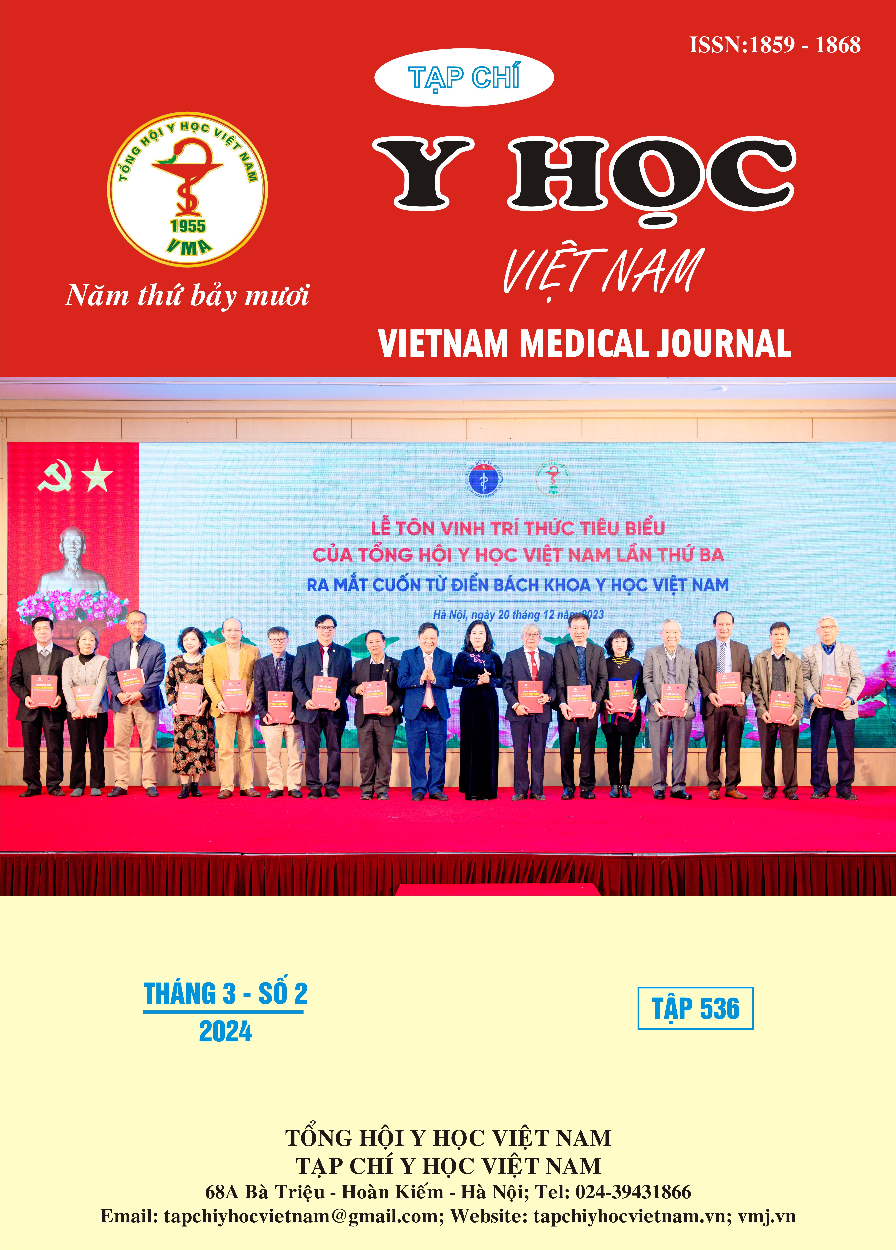CLINICAL FEATURES, LABORATORY TESTING AND SOME HEMODYNAMIC PARAMETERS MEASURED BY USCOM IN ANAPHYLACTIC PATIENTS
Main Article Content
Abstract
Objective: Describe some clinical and paraclinical characteristics and some hemodynamic parameters measured by USCOM in anaphylactic patients admitted to the Intensive Care Center - Bach Mai Hospital. Research method: Prospective descriptive study of all patients diagnosed with anaphylaxis according to WAO 2020 criteria, admitted to the Intensive Care Center - Bach Mai Hospital during the period from October 2022 to September 2023. Description of clinical indicators, blood lactate, creatinine, hemodynamic parameters of USCOM including SVI, FTc, SVV, CI, SMII, SVRI. Results: Among 41 patients eligible to participate in the study, the average age was 57.4 ± 21.0 years, grade 2 anaphylaxis was 29.3%, grade 3 anaphylaxis was 68.3%, grade 4 anaphylaxis was is 2.4%. Allergens due to drugs account for 68.3%, blood products 29.3%, other drugs 2.4%. The average lactate concentration was 4.73 ± 2.65mmol/L. Results of USCOM hemodynamic: 76.3% of patients had FTc ≤ 340ms, 21.6% of patients had CI < 2.5 L/min/m2, 19.5% of patients had SVRI < 1200 d.s.cm -5.m2, 30.6 has INO < 1.2W. Blood lactate concentration and SMII index were statistically significantly different between the anaphylaxis group of grade 3, 4 and anaphylaxis of grade 2, between the group of intramuscular injection of adrenalin delayed more than 30 minutes and less than 30 minutes. Conclusion: Patients with anaphylaxis in ICU are mainly at a critical level. Common allergens are caused by drugs. Paraclinical tests mainly increased blood lactate concentration. Most patients entering HSTC were given fluid resuscitation and maintained on intravenous adrenaline. However, USCOM results showed that 21.6% decreased cardiac output after anaphylaxis, 19.5% decreased systemic vascular resistance, 70.7% were hypovolemic and 30.6% of patients needed careful fluid replacement. Patients who were treated with intramuscular adrenaline injection more than 30 minutes late and had grade 3 or higher anaphylaxis had higher blood lactate concentration and lower Madigan Inotropy Index (SMII). USCOM is a device that can be applied to evaluate hemodynamic resuscitation for anaphylactic patients. More research is needed to further evaluate the effectiveness of USCOM parameters in hemodynamic resuscitation guidelines.
Article Details
References
2. Sala-Cunill A. and Cardona V. (2015). Definition, Epidemiology, and Pathogenesis. Curr Treat Options Allergy, 2(3), 207–217.
3. Cardona V., Ansotegui I.J., Ebisawa M., et al. (2020). World Allergy Organization Anaphylaxis Guidance 2020. World Allergy Organ J, 13(10).
4. Francuzik W., Dölle-Bierke S., Knop M., et al. (2019). Refractory Anaphylaxis: Data From the European Anaphylaxis Registry. Front Immunol, 10, 2482.
5. Nguyen K.-D., Nguyen H.-A., Vu D.-H., et al. (2019). Drug-Induced Anaphylaxis in a Vietnamese Pharmacovigilance Database: Trends and Specific Signals from a Disproportionality Analysis. Drug Saf, 42(5), 671–682.
6. Nguyễn Anh Tuấn (2018). Đánh giá hiệu quả điều trị phản vệ theo phác đồ của khoa Hồi sức tích cực, bệnh viện Bạch Mai. Luận Văn Y Học
7. Guerci P., Tacquard C., Chenard L., et al. (2020). Epidemiology and outcome of patients admitted to intensive care after anaphylaxis in France: a retrospective multicentre study. Br J Anaesth, 125(6), 1025–1033.


